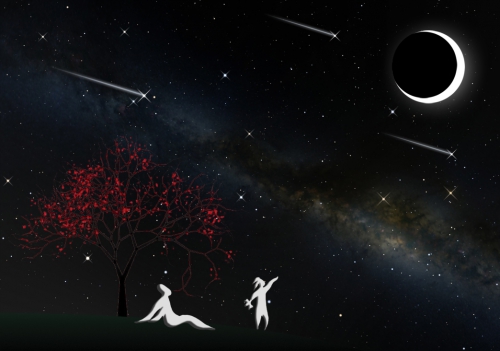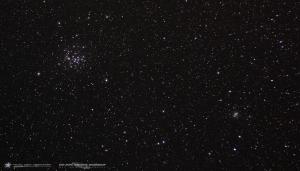
Stargazing Nights
- Where:
- Frosty Drew Observatory
- When:
- Friday May 10, 2019 at 8:30 p.m
- Cost:
- $5 Suggested Donation per person 5 years and older
Tonight is Stargazing Night at Frosty Drew Observatory, and forecasts continue to pummel our Friday night geek outs. Tonight’s weather will bring the usual showers, t-storms, clouds, and now fog as well. Though there is a glimmer of hope. A lot of variability exists in forecasts we are monitoring. Some of our most reliable forecasting sources are calling for a period of partial clearing between 8:30 pm and 11:00 pm, which is right in the middle of our session. Being that we have the 38% waxing crescent Moon out tonight, we just may sneak a peek through thinner clouds. This is all great as long as fog doesn’t sock us in. Having zero viewing for the past 8 Friday nights, makes this possibility is too tempting to pass up, so we’ll give it our best shot.
The Observatory and Sky Theatre will open at 8:30 pm tonight. In the Observatory, telescopes will start off on standby as we evaluate sky conditions. If clouds clear out enough, we will direct the primary observatory telescope towards the crescent Moon, which will be passing in front of the Messier 44 open star cluster (occultation). Sky conditions will determine how many other objects we can view tonight, though May is galaxy month and we are set up at Frosty Drew Observatory to observe the wonders of the Virgo Supercluster, a huge cluster of galaxies that the Milky Way is part of. In the Sky Theatre we will show our usual feature of celestial objects previously photographed at Frosty Drew. Check in frequently on our Twitter (@FrostyDrewOBSY) or the bottom-right column of our website for updates from the observatory on what we are seeing, including a “Closing up” post when we decide to start packing up.
Overall, tonight is certainly looking like another cloud attack. Though a creditable possibility exists for partial clearings, enough to catch sight of the crescent Moon. If you’re making the long drive, this will be a night to skip, it’s too risky, and overall conditions will still be poor. But if you’re somewhat local to Frosty Drew, then stop in, catch up on your geek, and potentially catch a view of the Moon occulting the M44 cluster. Clouds begone!
--------------------------------
Weekly Happenings
Scott MacNeill
Tonight, Friday, May 10, 2019 a fabulous occultation of the Messier 44 open star cluster will occur when the Moon, in its orbit around Earth, overtakes our view of the bright star cluster. Starting at 10:00 pm and continuing until midnight, the Moon will slowly overtake the lower portion of this visibly large cluster of stars. It takes 27.3 days for the Moon to complete one orbit around the Earth, which it does 5° inclined to the Ecliptic, which is the path the Sun takes across the sky and represents the plane of the Solar System. The Moon orbits Earth in a prograde orbit, which is counter clockwise in relation to the north pole. Even though the Moon appears to move with the stars every night, due to Earths axial rotation, the Moon is actually moving eastward at a rate of about 0.55° per hour. This motion allows for the Moon to visually encounter stars within 5° of the ecliptic periodically, including the Sun (solar eclipse). The Messier 44 cluster resides about 1° from the Ecliptic, which makes it applicable to lunar occultations. Now occultations are not visible to everyone on Earth, and are generally only visible when the Moon and the object in question are both above the horizon and in the night sky over a viewers location, with the exception of Venus and maybe Jupiter, which would be visible in the daytime sky as well. The Messier 44 occultation tonight will be visible to the entire East Coast US with the rest of North America seeing part of the occultation. To watch the entire event, step outside around 10:30 pm with binoculars or a small telescope with a low power (magnification) eye piece and direct your view towards the Moon. You will notice a somewhat faint cluster of stars orientated on the shadow side of the Moon’s crescent. Over the next 90 minutes, watch star by star disappear from your view behind the Moon and then slowly emerge along the other side of the Moon. If you catch a photo of the occultation, be sure to post it on our Facebook and we’ll share it on our time-line.
After nearly two weeks of non-stop cloud cover, the skies cut us a break overnight this past Monday – Tuesday, May 6-7, 2019. A frequent visitor to Frosty Drew Observatory as well as an avid astro geek, hit me up with the possibility of taking advantage of this much needed clear night with practically no Moon. We setup just after sunset and sat out under the beautiful starscape until the morning Sun started to creep in. On our viewing list were numerous galaxies in the Virgo Supercluster as well as nebulae, star clusters, dark nebulae. and the bright morning planets. We collected many of our first views of 2019 that night, including a fabulous photograph of the Milky Way rising over Frosty Drew Observatory in the early morning hours. April - July is the best time to catch sight of the Milky Way at Frosty Drew Observatory, though the Moon and clouds all make for dastardly viewing conditions. The following night (Wed-Thu) was equally fantastic. Check out Tuesday morning’s photo of the Milky Way, then put forth some serious hope that fabulous nights like this return regularly to the skies over Frosty Drew Observatory.


